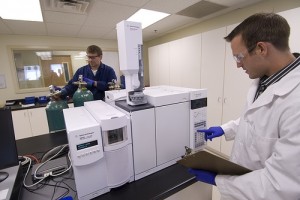Part 16: Finding Pure Essential Oils
8. Are all gas chromatograph instruments the same, and will the analysis be the same from all GC instruments?
No!
There are several different makes of GC instruments, but that is not what makes the difference. The instrumentation inside is where the accuracy is determined. In America, essential oils were not a subject of much interest until I started teaching and comparing oils in 1991. All GC instruments that I saw in every university that I visited had only 30-meter columns, since their primary purpose was to analyze plant compounds, not oils.
There is a huge difference in the length of a column, which is a very tiny, glass tube coated with a polymer to make it flexible. The oil flows through the glass columns inside a heated chamber called an oven. These columns are kept at a constant temperature, heating the oils to varying degrees between 250 to 300 degrees Fahrenheit.
The heat causes the compounds to separate based on their flash point or volatility. The intensity of the combustion causes a movement inside the machine that marks the length of the combustion and the strength of the molecule in the computer graph, which also gives us the percentage of the different compounds. The time that it takes the oil to flash off is measured in retention time and area width and is digitally recorded and given an identity number.
Another factor is the thickness of the wall of the column. Different thicknesses give different response times. The length of the column determines if all the molecules will separate. If the column is not the right length, some molecules hold together, preventing an accurate reading and leaving many molecules unknown and unidentified. The wall thickness in most of the GC instruments in the United States is 0.20 to 0.32. The thinner the wall, the quicker the flash point, which works well for measuring petroleum and synthetic compounds because they have very few numbers and have no need for great separation.
With the essential oil complexity of hundreds of compounds, the thinner the wall, the more likely multiple compounds will flash together, giving an incorrect reading. To obtain more accuracy, a thicker column wall is essential to get a great area width of separation and to reduce the chance of losing some of the molecules. That is why we use the same specification as the CNRS laboratory with Dr. Casabianca, which is 0.50 to 0.52.
To assure the best separation, I use two columns, one 50-meter and one 60-meter—polar and non-polar. Polar and non-polar have different wall coatings that affect different molecules, enabling optimal molecule separation. These columns are especially designed for fine- and multiple-complexity molecules found in essential oils. For example: A 30-meter column will detect 8 to 9 major compounds in melissa essential oil. A dual 50–60-meter column will detect 72 major compounds and 124 minor compounds.
To be continued . . .



Would you like to share your thoughts?
Your email address will not be published. Required fields are marked *